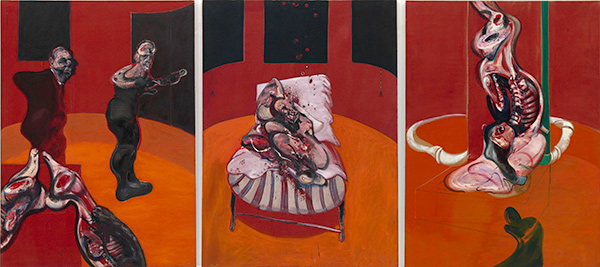
Three Studies for a Crucifixion
Three Studies for a Crucifixion, 1962
Oil on canvas, triptych
198.1 x 144.8 cm each
Solomon R. Guggenheim Museum, New York, 64.1700
© The Estate of Francis Bacon. All rights reserved. DACS/VEGAP. Bilbao, 2015
“Triptychs are the thing I like doing the most, and I think this may be related to the thought I’ve sometimes had of making a film. I like the juxtaposition of the images separated on three different canvases. So far as my work has any quality, I often feel perhaps it is the triptychs have the most quality.” Francis Bacon, 1979 [1]
Francis Bacon (b. 1909, Dublin; d. 1992, Madrid) began to consider launching a career in painting after he saw an exhibition on Pablo Picasso (b. 1881, Málaga; d. 1973, Mougins) in Paris’s Paul Rosenberg gallery in 1927. Picasso’s anthropomorphic figures so impressed Bacon that he decided to become a self-taught painter. In 1929, he returned to London, where he informally picked up some drawing and painting techniques. At the same time, he began to work as an interior decorator and designer of furniture, rugs and tiles. Bacon painted regularly, and he destroyed the works that he deemed were not good enough. In 1933, a work of his was reproduced in the Herbert Read book entitled Art Now: An Introduction to the Theory of Modern Painting and Sculpture. It was Crucifixion (1933), which appeared in a prime location just across from Picasso’s Bather (1929). Even though Bacon received this recognition at the start of his career and at a relatively young age, he did not enjoy the same good fortune in the subsequent years.
Between 1936 and 1943, Bacon practically stopped painting. During the early years of World War II, he served in a civil capacity because of his chronic asthma[2]. In 1944, one of the most devastating in World War II, he painted Three Studies for Figures at the Base of a Crucifixion (1944), a horrifying triptych which shows anthropomorphic creatures writhing in anguish. This work served as the seed of series of large-scale triptychs that Bacon later painted—the first was Three Studies for a Crucifixion (1962) [3]. In this work, Bacon treats the religious subject as a metaphor of human suffering, depicting the crucified figure as a dismembered corpse [4]. In contrast to traditional religious triptychs, the three panels are totally independent: their scenes are connected but do not tell a single story and are not a unified whole. However, the three panels are tied together by their backgrounds, which are virtually monochromatic fields of simple, uniform bright oranges and reds that cover the cylindrical space in which the figures are located. These figures, which are in the foreground, are treated in the opposite fashion, with a rich color palette; their complex forms stand out and are projected thanks to the uniformity of the space around them.
On the right panel of Three Studies for a Crucifixion (1962), Bacon shows a figure whose composition is reminiscent of the traditional scenes of Christ on the cross. On the left panel, two men seem to be in a butcher shop where the counter displays cuts of meat. However, the central panel is where the most important object is found: the bed, where the body writhing in pain is lying. To the artist, the bed is the place where everything begins and everything ends.
Preguntas
Look carefully at Bacon’s painting for a few minutes. What is happening in the scene?
Pay attention to the first panel on the left. Describe the figures that appear in the painting. Who might they be? How would you describe their faces? What about their clothing? Where do you imagine they are? What is that place like? What do you think they’re doing there? What emotions or feelings does this work arouse in you? Why?
Now look at the middle panel. What do you think is happening to this figure? Why is s/he in a bed? What mood, feeling or sensation does this part of the painting inspire in you?
Finally, look at the right panel. What do you see? Describe what you see in detail. What does it remind you of? Have you ever seen anything similar? Where? What does it make you feel? Why?
Even though all three panels are independent, their scenes are connected to each other. How do you think the painter manages to tie them together? Remember what each part made you feel: how are these feelings similar? How are they different?
The triptych is called Three Studies for a Crucifixion. Why do you think it was given this title? Do you think it suits the painting? Why? If you could change it, what would you call it?
